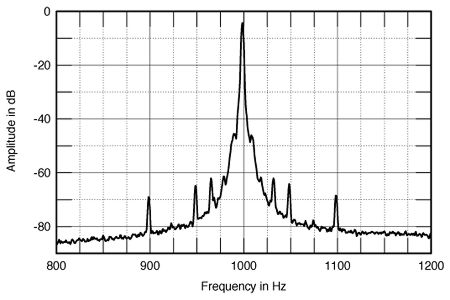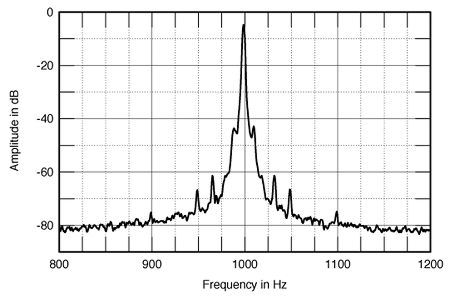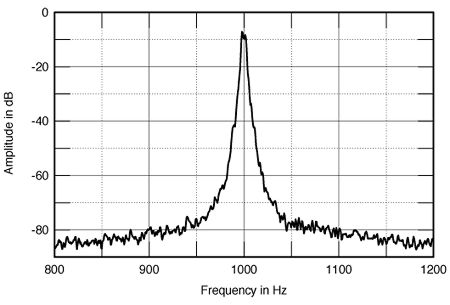| Columns Retired Columns & Blogs |
Linn LP Playing System Measurements
Sidebar 3: Measurements
Footnote 1: To expand my measurement database, I welcome readers sending me audio files of their turntables playing back 1kHz tones. Files should be 16-bit, 44.1kHz- or 48kHz-sampled mono WAVs or AIFs, and should be at least 20 seconds in length (but no longer than two minutes). Please note in your e-mail the test LP used, the nominal recorded velocity of the tone, and the soundcard and playback equipment used. Send me the files at Stletters@Primediamags.com.—John Atkinson
Other than the new Akiva cartridge, all the Linn Products products reviewed by Mikey this month have been reviewed before in Stereophile. Wes Phillips favorably reviewed the Linto phono preamplifier in June 1998 (Vol.21 No.6), and my measurements accompanying that review revealed that it was extremely quiet, even in its high-gain mode, with an A-weighted signal/noise ratio of 85.3dB (ref. 500µV input at 1kHz), and an unweighted, wideband ratio of 66.5dB, which is still excellent. The voltage gain at 1kHz was 62dB, and the RIAA error showed a very slight (0.25dB) downtilt from 100Hz to 20kHz, which might be audible. The overload margin at 20Hz was 20.3dB, which is good, but this dropped to 16.8dB at 1kHz and 16.3dB at 20kHz, both figures only adequate.
I reviewed the Ekos tonearm very favorably in April 1989 (Vol.12 No.4). Some commentators have reported problems with increasing bearing friction over the long term, but the sample I bought 14 years ago still appears to be okay in this respect.
In its various incarnations, the Sondek LP12 turntable has been reviewed a number of times in Stereophile: first by Larry Greenhill in February 1984 (Vol.7 No.2), then by Martin Colloms in March 1990 (Vol.13 No.3), then by Corey Greenberg in December 1991 (Vol.16 No.12). The effect of the Lingo power supply was first described by me in January 1991 (Vol.14 No.1), with a Follow-Up by Wes Phillips as part of his report on the Naim ARO tonearm and Armageddon LP12 power supply in February 1996 (Vol.19 No.2). Robert Deutsch also commented on the improvement wrought by the Cirkus base in May 1997 (Vol.17 No.5).
My reaction to the external Lingo supply, comparing it back in late 1990 with the older Valhalla board, was very positive. In particular, I felt the low frequencies were reproduced with considerably better extension and definition. I performed some basic measurements on the combination of the Lingo-driven Sondek with the Ekos and a Linn Troika cartridge in my 1990 review, which are reproduced in the Web reprint. In comparison both with the LP12 Valhalla and an Australian Aura turntable fitted with an early Graham tonearm, the LP12 Lingo had slightly better speed stability, evinced by the slightly narrower "skirt" around the spectral peak representing a 1003Hz tone from the Denon Test LP. However, low-level sidebands were visible both at the 11Hz frequency of the tonearm-cartridge suspension resonance and at ±50Hz, the latter not uncoincidentally the frequency of the Lingo's synthesized sinewave supply. Rumble was very low.
I had performed those 1991 measurements using the DRA Labs MLSSA system, which has a 12-bit A/D converter. When Mikey and I arranged for him to review 2003 samples of the Linn LP player, I thought it might be interesting to repeat those measurements with a 24-bit converter (a Mobile IO 2882 from Metric Halo, hooked up to my Titanium PowerBook running Bias Peak 4), first with the 1990 Lingo, then with a 2003 sample. (The new Lingo uses a slightly different circuit, realized with surface-mount components and housed in the same, larger case as the Linto.)
Fig.1 shows a narrowband FFT spectrum of the LP12's output powered by the original Lingo, playing a tone with a nominal frequency of 1kHz and a recorded velocity of 5cm/s. The tonearm was my 1989 Ekos, the cartridge an early sample of the now discontinued Arkiv, and the spectral analysis was performed using Adobe Audition (previously called Cool Edit Pro) set to a 65,536-point FFT size and a Blackman-Harris window. The measured playback frequency was 998.5Hz, but as I don't know the accuracy of the tone recorded on the test LP (HFS 81, produced by the late John Wright for the long-defunct UK magazine Hi-Fi Sound), the 1.5Hz difference can't be used to judge the LP12's speed accuracy.

Fig.1 Linn Sondek LP12-Ekos-Arkiv with Lingo (1990 sample), spectrum of 1kHz sinewave, 800-1200Hz, at 5cm/s (linear frequency scale).
The tonearm resonance with the Arkiv lay at 10Hz; the "shoulders" at exactly 10Hz on either side of the central peak are due to this resonance. They lie at -41dB ref. 5cm/s, so it's hard to predict what their subjective effect will be. Small spurs at ±20Hz, the second harmonic of the tonearm resonance, can also be seen, but these are 60dB down in level.
Three more sideband pairs can be seen, at ±33Hz, ±50Hz, and ±100Hz. The last two pairs clearly derive from the Lingo's 50Hz drive signal. While at a low level—-60dB and -64.5dB, respectively—the asynchronous motor's "cogging" has not been completely eliminated by the low-pass filter formed by the drive-belt compliance in combination with the inertia of the turntable's rotating platter. But I have no idea where the 33Hz sidebands at -57dB stem from.
Fig.2 was taken with the same playback equipment under identical conditions, other than the substitution of the 2003 sample of the Lingo. The central peak still lies at 998.5Hz, and the tonearm-resonance-related sidebands at ±10Hz and ±20Hz are still evident. However, while the sidebands at ±33Hz and ±50Hz are only a little lower than in fig.1, the 100Hz sidebands have been reduced by almost 10dB. This suggests that the latest Lingo outputs a more harmonically pure sinewave.

Fig.2 Linn Sondek LP12-Ekos-Arkiv with Lingo (2003 sample), spectrum of 1kHz sinewave, 800-1200Hz, at 5cm/s (linear frequency scale).
This is interesting stuff, though I have not measured anything like enough turntables to know how it correlates with the listening experience (footnote 1). The only other turntable-tonearm combination I have spectral data for is a Pioneer PLL-1000 direct-drive turntable, which had its parallel-tracking tonearm fitted with a Audio Technica 8008 cartridge. (This turntable was also sold in the US in the late 1970s with a Phase Linear badge. My thanks to reader Carl Valle for sending me a WAV file of its playback of a 1kHz tone.) A narrow-band analysis of its performance is shown in fig.3. Slight shoulders can be seen at ±11Hz, which are due to the fundamental tonearm-mass/cartridge-compliance resonance, but the 65,536-point FFT can't resolve any other wow & flutter spuriae. The central trace is wider than that of the Lingo-driven LP12, but there are no higher-frequency sidebands visible.

Fig.3 Pioneer PL L1000-AT 8008, spectrum of 1kHz sinewave, 800-1200Hz, at 5cm/s (linear frequency scale).
Returning to the subject of this review, it is a tribute to the Scottish company that their LP12 turntable, now almost 30 years old, still offers technically competitive performance.—John Atkinson
Footnote 1: To expand my measurement database, I welcome readers sending me audio files of their turntables playing back 1kHz tones. Files should be 16-bit, 44.1kHz- or 48kHz-sampled mono WAVs or AIFs, and should be at least 20 seconds in length (but no longer than two minutes). Please note in your e-mail the test LP used, the nominal recorded velocity of the tone, and the soundcard and playback equipment used. Send me the files at Stletters@Primediamags.com.—John Atkinson
- Log in or register to post comments




































